Todo de la escuela, 2017
Las fotos de cada clase, tomado en febrero. Los primeros dos son nuestras clases de Kinder…
y despúes, primer, segundo, tercer, cuarto, y quinto/sexto grados.
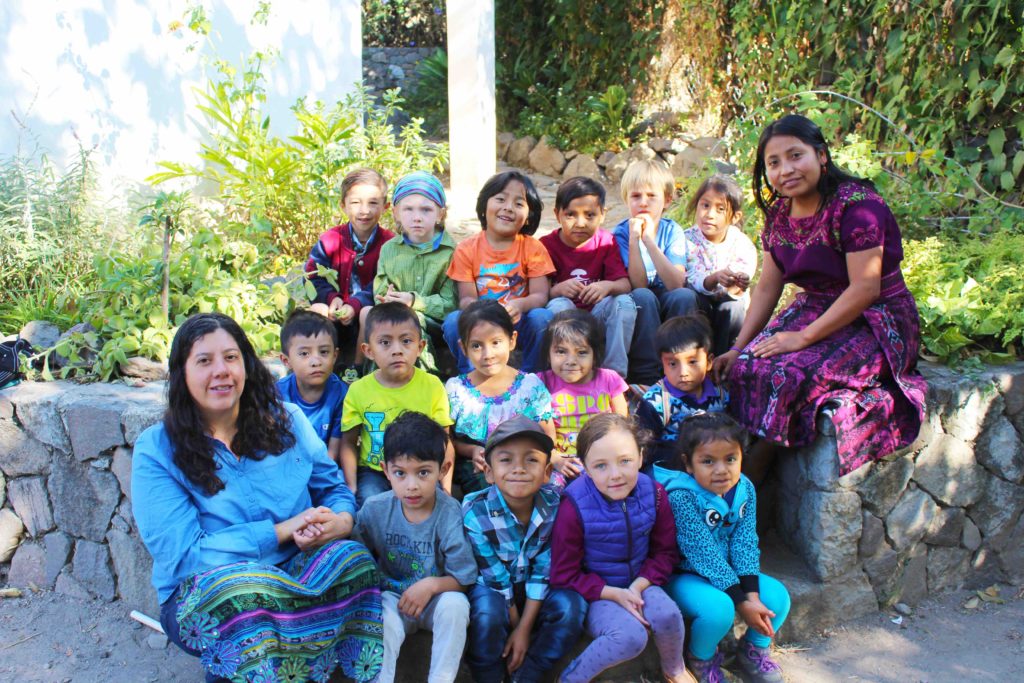
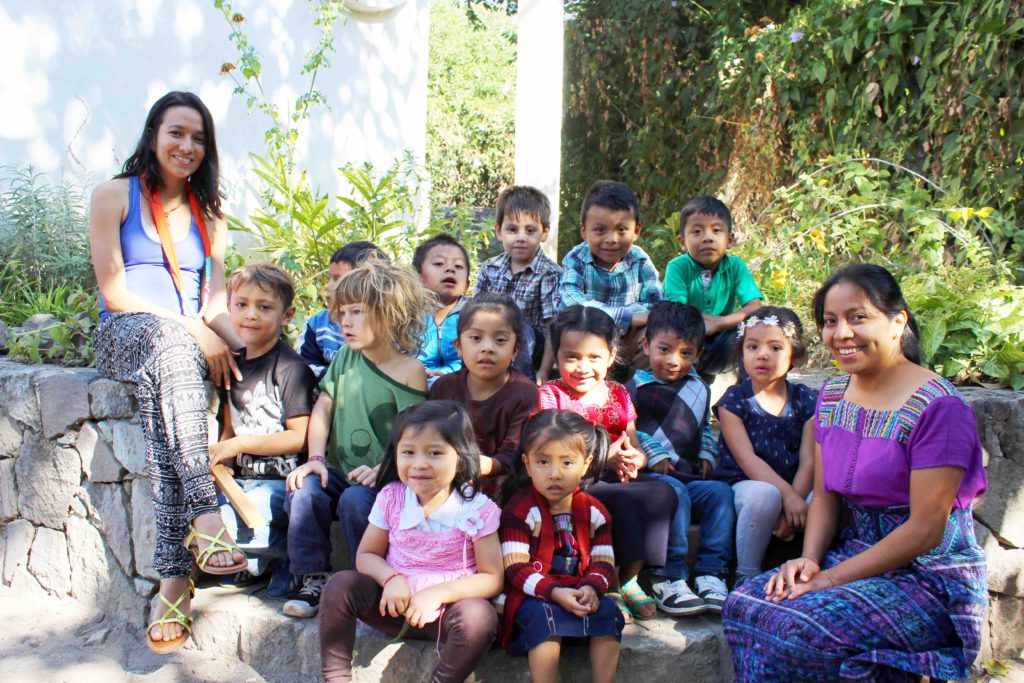
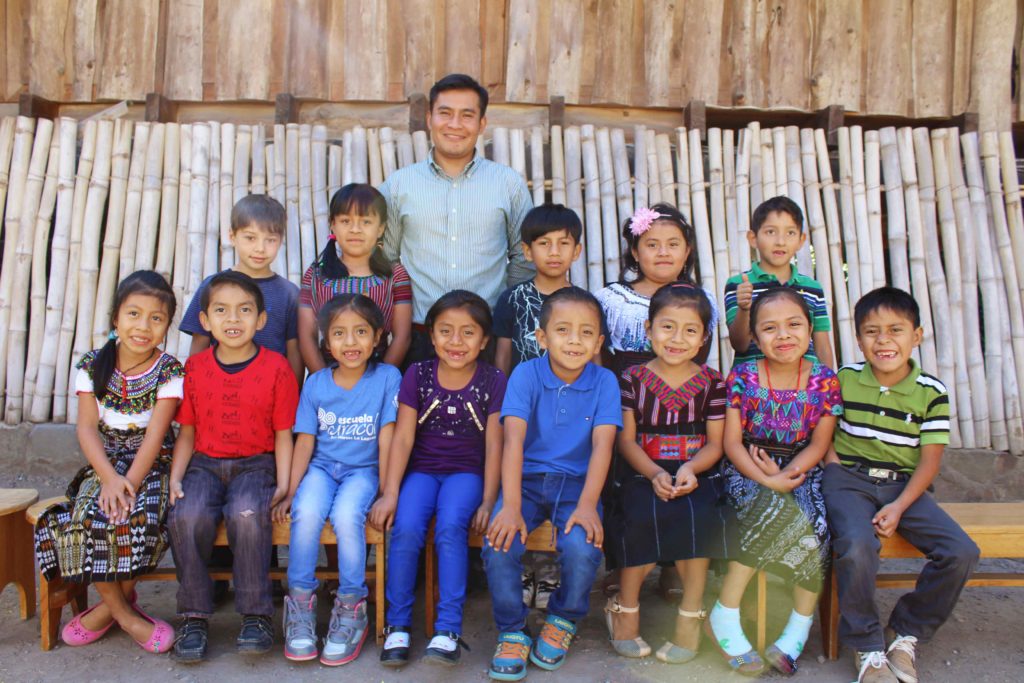
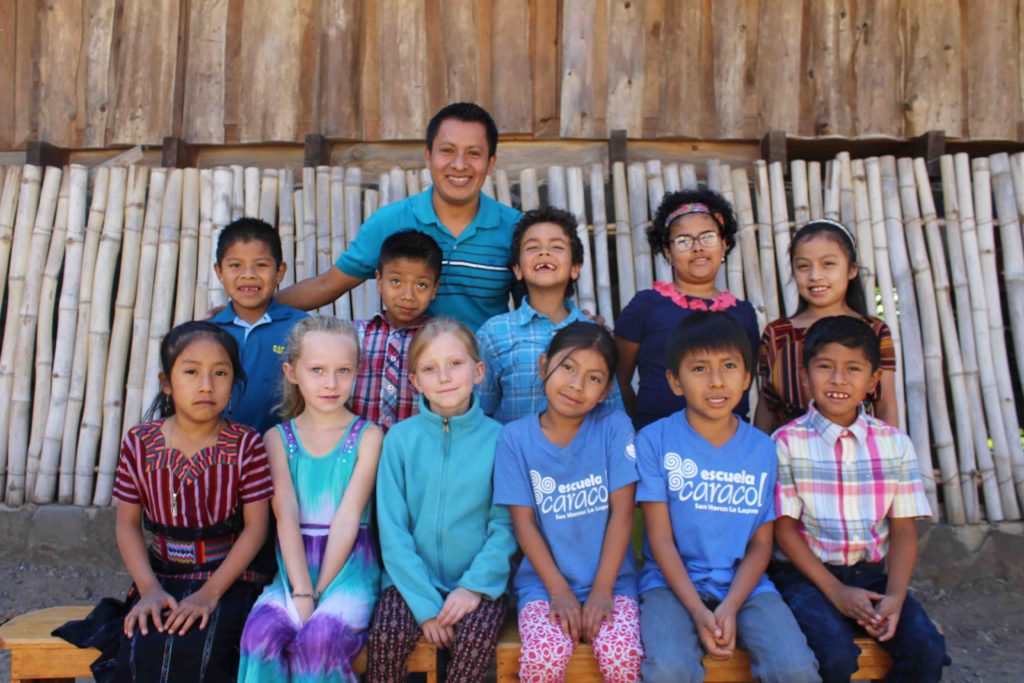
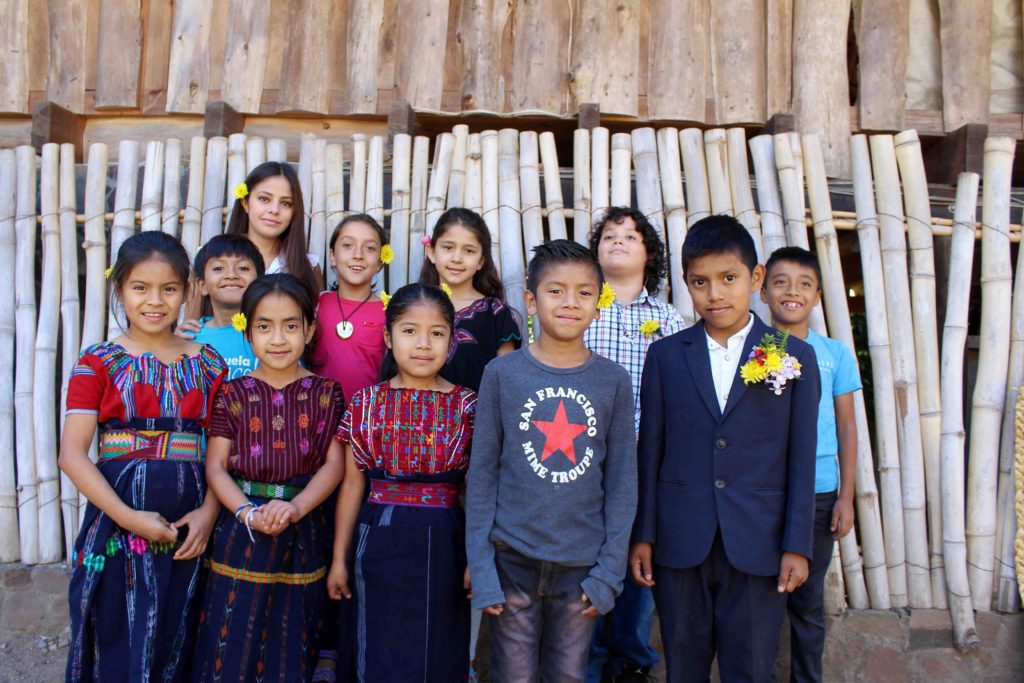
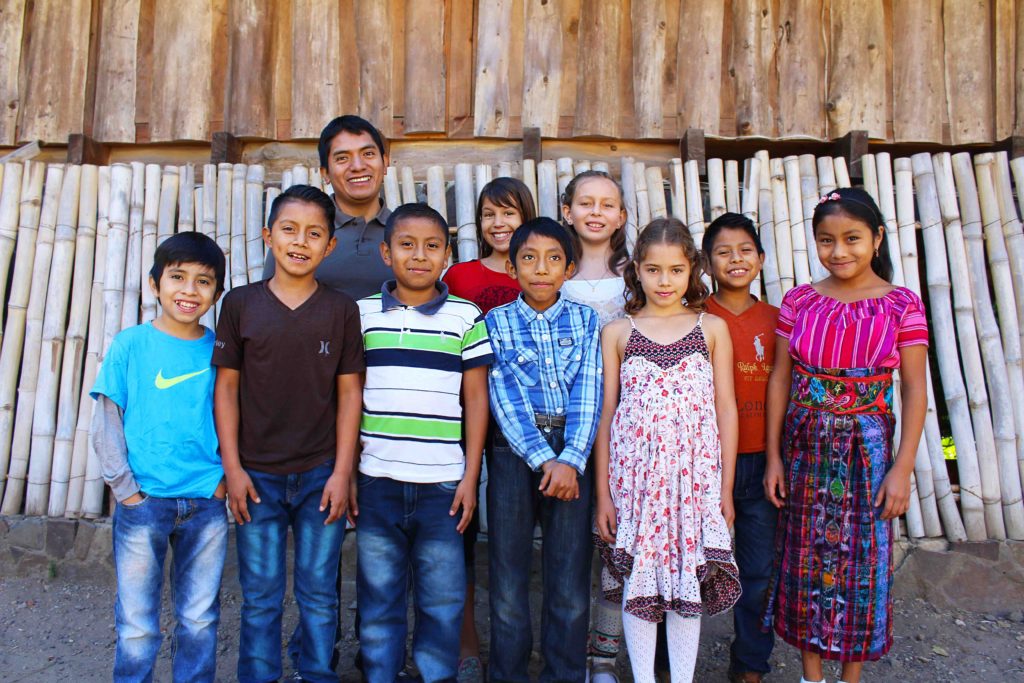
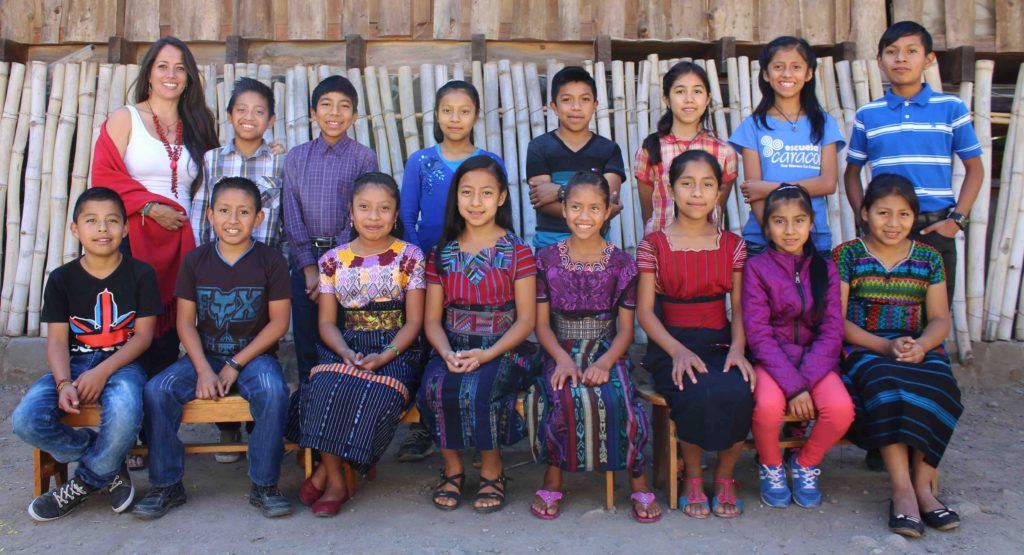
Las fotos de cada clase, tomado en febrero. Los primeros dos son nuestras clases de Kinder…
y despúes, primer, segundo, tercer, cuarto, y quinto/sexto grados.







In 2017, Escuela Caracol celebrates its 10th year. In honor of this anniversary we are recounting our history and remembering how this happy sanctuary came to be, with a campaign called «10 Years of Stories.» To begin, here’s our origin story, from Dr. Allen Wilson, father of co-founder Joshua Wilson:

Nicolás Sacach Mendoza in 2007
When my wife, Suzanne and I, first visited the property on which the school exists, the only building existing was what is now the office and area outside the office (plus a small bodega). This building was the home of Joshua and Courtney, the founders, for many months. The first classroom to be built is the classroom which is adjacent and just down the steps from the the kitchen. At that time there was only a couple of trees and lots of boulders and rocks on that site. Josh’s vision for the classroom was that it be built as a Golden Rectangle, whose dimensions are based on the Golden Ratio, also known as the Divine Proportion. What exists today is the result of this vision, and the hard work done by the first Guardian of the school, Nicolás Sacach Mendoza. Nicolás had been working on the property where the school is located since 2001, and continued to do so when the school was founded in 2007.

The founders with their daughter in 2007
The memory I want to share is of the groundbreaking for the new classroom in July of 2007. From the moment the first shovel full of dirt was lifted, we realized that building a classroom on the existing property would be a huge task. Every thrust of a shovel seem to hit rock. The more we dug, the larger the rocks seem to get… I’m talking boulder-size! I was totally amazed at the skills that Nicolás used to chisel and sledge hammer the boulders into manageable sized rocks. Nicolás was not a tall man, but he was stocky and built as strong as the rocks we were attempting to remove. Each blow of his hammer on the chisel held in his steady hands produced what felt like a small earthquake to the ground on which we stood. Every powerful blow produced a muffled grunt from his mouth and another bead of sweat on his brow, but he never lost the smile on his face. He worked tirelessly from sun-up until sun-down for days, until the three-foot deep footing for the foundation of the classroom was dug. Upon completion of the trenches for the footing, he and several other friends worked for days mixing the ingredients for the concrete, and masterfully pouring the footings.
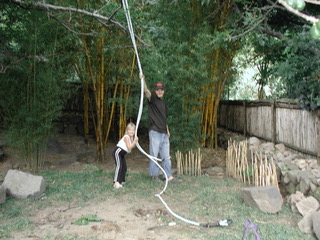
The swing at Escuela Caracol
On October 30, 2016, Escuela Caracol held its first formal Jocote Festival, inviting vendors, musicians and visitors from around Lake Atitlán. This festival was held with a threefold purpose: to help raise money for Escuela Caracol, to invite the regional community to get to know the school, and to celebrate the harvest season and local traditions of this time of year. The Jocote Festival was a great success, with over 300 people attending.
Chief among the harvest in San Marcos is the jocote (see below about jocotes), but other important harvests include corn and many types of squash. This time of year is also when the Day of the Dead is celebrated and loved ones who have passed are remembered. Associated with this holiday in Guatemala are two important traditions: flying kites and making coronas, which are colorful wreaths of cypress branches and flowers which are taken to adorn grave sites. At the Jocote Festival the Caracol first grade class hosted a corona-making workshop while the sixth graders offered a kite-making workshop. In addition to the workshops, harvest foods, musicians and vendors, games were offered with special local themes, like a jocote seed spitting contest and races carrying baskets on top the head.
Rounding off the event toward the end of the day was a special guitar performance by Caracol’s sixth graders, now calling themselves Flor de Jocote. («Jocote Flower»). Watch their performance below!
It was a beautiful day with a warm and lively atmosphere, and we look forward to developing it further in the years to come.
WHAT IS A JOCOTE?
The jocote ( is a special fruit in San Marcos, which is known regionally as la tierra de los jocotes («the land of the jocotes»). The people of San Marcos take great pride in their jocotes, which come in many varieties. This time of year one will often catch even adults knocking the fruits down with a long cane or walking along the path with the pit protruding from within their cheek. The fruits are high in vitamin C, iron and calcium, and locals often attribute their robust health to the jocotes.
At the end of August, Escuela Caracol was blessed once again by the visit of master Waldorf teachers who wanted to volunteer their time with us. This time, we were fortunate to receive Felix and Beatrice Zimmermann from the Rudolf Steiner School of Wetzikon, Switzerland. Felix specializes in the primary and secondary grades, and Beatrice is a kindergarten teacher, so they make an excellent pair. They spent a total of three weeks at Caracol, observing classes, mentoring teachers, and giving talks and workshops on Waldorf education. One of Felix’s talks was on the «Musical Moods and their Significance in Education.» Here is a short video of him playing the flute.
Another very special contribution they made was the addition of a beautiful spinning wheel to our handwork equipment. Beatrice spent considerable time showing our kindergarten teachers and handwork teacher how to use it. The children are at once intrigued and comforted by its use in the classroom. Thank you, Felix and Beatrice!
The Zimmermann’s visit was made possible in part by the generosity of Caracol neighbors, Ron and Kim Wilhelm, who donated the use of their gorgeous house for the Zimmermanns. Many thanks, Ron and Kim!
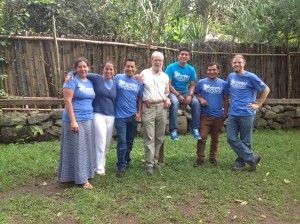
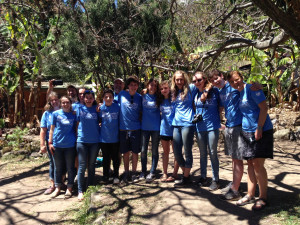 In February, Escuela Caracol was fortunate to host a group of Waldorf students and parents from the state of Vermont in the US. The family who organized the visit is a Caracol alumna family, the Devoe Tallutos. Their family of five spent a year at Caracol in 2009, and since then they have returned to visit us many times. This year they decided to invite members of their community at the Lake Champlain Waldorf School in Vermont come along with them. In total, they were a group of 14 students and parents who were interested in both Guatemala and Waldorf education. While at Escuela Caracol, the group worked tirelessly on a number of projects: they built a new coop for our chickens and a small pond for turtles, they designed and made costumes for our class 4/5 play, and they refinished the doors on the primary grades classrooms (which were in a sad state from the extremities of sun and rain here). They even took their break times to play with our students and show them how to make jump ropes. During their weeklong visit, they also found time to pour the foundation of a local home, climb a moutain peak to watch the sunrise over the lake, attend a dance class at La Cambalacha, learn how to make tortillas, kayak on the lake, take in many sights, and of course go swimming. Their work was a huge help to Escuela Caracol, and the visit was equally meaningful to the group. Many of the students are already talking about their next visit to Guatemala. Escuela Caracol sends its thanks to this group, and especially to the Devoe Talluto family!
In February, Escuela Caracol was fortunate to host a group of Waldorf students and parents from the state of Vermont in the US. The family who organized the visit is a Caracol alumna family, the Devoe Tallutos. Their family of five spent a year at Caracol in 2009, and since then they have returned to visit us many times. This year they decided to invite members of their community at the Lake Champlain Waldorf School in Vermont come along with them. In total, they were a group of 14 students and parents who were interested in both Guatemala and Waldorf education. While at Escuela Caracol, the group worked tirelessly on a number of projects: they built a new coop for our chickens and a small pond for turtles, they designed and made costumes for our class 4/5 play, and they refinished the doors on the primary grades classrooms (which were in a sad state from the extremities of sun and rain here). They even took their break times to play with our students and show them how to make jump ropes. During their weeklong visit, they also found time to pour the foundation of a local home, climb a moutain peak to watch the sunrise over the lake, attend a dance class at La Cambalacha, learn how to make tortillas, kayak on the lake, take in many sights, and of course go swimming. Their work was a huge help to Escuela Caracol, and the visit was equally meaningful to the group. Many of the students are already talking about their next visit to Guatemala. Escuela Caracol sends its thanks to this group, and especially to the Devoe Talluto family!
Several years ago, after my class 5/6 had completed their performance of a Roman history themed play, a local indigenous parent at Escuela Caracol asked me, «Why are our children even studying Roman history? It feels so foreign and remote from our Mayan culture, and its legacy of conquest is such an ugly stain on the Americas. What does Rome really have to do with us anyway?» I contended that one could not fully understand our modern globalized world without some knowledge of and feeling for Ancient Rome. I also pointed out that he himself is a member of the (Roman) Catholic Church. It was a healthy interchange that left a lasting impression on me of the critical importance of bringing such historical studies into living conversation with our local Mayan context.
At the start of this year, our current sixth grade teacher, Diego Sacach Mendoza, approached me for help in planning his first block of the year: Ancient Rome. He was enthused and energetic to learn more about this subject and bring it to his class of all indigenous students. So we started at the beginning, with the founding myth of Rome: Romulus and Remus. These two boys, fathered by Mars and raised by a she-wolf, eventually decide to lay claim to their respective territories. Romulus builds a wall to keep out uninvited guests, Remus flaunts his disrespect for this wall by jumping over it, Romulus slays his brother Remus, and thus Rome is founded.
Diego stopped me there. When he was a child, he said, there were no walls whatsoever in San Marcos. People had lands that they cultivated and took care of, but no one ever put up walls — neither around fields nor houses. The walls, he said, began when outsiders came and settled. It was the first thing they would build. I told Diego to run with that thought — and he did.
After telling his class about these Roman brothers, they took a walk back in the mountain where someone had recently bought land. The
students observed that the first thing the owner had done was to clear the land and put up a wall. We have so much stone here that dry stone walls are the most common method. Some students love to play and experiment with stone building at school. The next day in class, the students discussed the nature and purpose of such walls. How are they built? Why are they built? What is their function? Do they work? One student said that her grandfather told stories about a time when there were no walls in San Marcos. So Diego gave them all the assignment to go home and investigate with their parents and grandparents what San Marcos was like when they were kids.
The next day they shared their research together. They learned that there was a time before walls in San Marcos. They shared stories of adventure when kids could run freely across all the land of San Marcos. They also heard that people did in fact deal with thieves during those days. So Diego decided to organize a class debate, with one side arguing for and the other against the necessity of walls.
Sixth grade is about meeting and observing the physical, concrete
world directly, and then moving those observations into the newly budding world of thought. The stone wall of Rome proved to be a perfect topic. The experience was energetic and challenging for the students, and it raised more questions than answers. The question of walls is perennial. It is at once practical, philosophical (do «good fences make good neighbors»?) and even geopolitical (the Great Wall of China, Hadrian’s Wall, the Berlin Wall, the current talk of a US/Mexico wall).
Perhaps most importantly for our context, the question of walls touches on the question of Maya and non-Maya integration in our community, and this difficult, delicate and poignant question is at the heart of our work at Escuela Caracol.
Guest post by Colleen Donovan, a Kindergarten Teacher at Escuela Caracol:
This month, I’d simply like to share a story with you. It is a story I wrote for my class during our first few weeks together, after watching the children come to class day after day tired, cranky, and fussy. Think of how you feel when after a few nights of bad sleep a colleague says something to you that gets under your skin (something that likely wouldn’t have bothered you at all had you been well rested). I’ll bet that you have said things under these circumstances that you later regretted.
Now think of 15 children, ages 3 to 6, who feel like this. When one of them is irritated by a classmate, a sarcastic remark is not the only reaction. At that age impulse control is still hard at the best of times; when you have a group of overtired children, impulse control goes out the window. After about two weeks of this situation, I admit that I was nearly at my wit’s end. This clearly wasn’t just a blip on the radar, my students were really struggling to get through the morning. What could I do to help them?
Naturally, there isn’t just one solution. Talking to parents individually, having a class meeting on the importance of sleep, and changing our daily rhythm to include rest time have all helped to alleviate the burden these children were carrying. Another way we can help our young ones is through stories.
Storytime can be one of the most magical moments of the day. In Waldorf kindergartens we often tell fairy tales—so rich in language and imagery—or seasonal tales, related to the cycle of the year. We also tell “therapeutic” tales, which can help a whole class or an individual child to overcome a struggle by presenting the problem in a loving and nonjudgmental way, and showing that there can be a satisfactory resolution. Another benefit of working through troubling behavior with a story is that we avoid singling out the child and leaving him or her with the stigma of being a “problem child.” Crafting a story for children you know using your love, interest in them, and creativity is a wonderful gift to give them. I encourage everyone to try! As you can see, my story is neither complicated nor long; it is simply one created from a desire to help. If you’re interested in learning more about therapeutic storytelling, I recommend Susan Perrow’s book Healing Stories for Challenging Behavior.
Turtle Loses His Shell
Those who know turtles know that their shells grow hard and strong during the night, while they are fast asleep. But every night when Turtle laid down, the noise of the crickets was so loud he could not sleep. Night after night, Turtle did not sleep, and little by little his shell grew soft and weak. One morning Turtle was surprised to find that his shell had disappeared completely during the night! Surprised, he went to the pond to find his friends Frog, Duck, and Fish, and they all began to play together, telling jokes and searching for delicious treats.
But something was not going well for Turtle. He was in such a bad mood! When Fish swam into him accidentally, he gave her a sharp nip with his beak. And when Duck’s foot grazed his back as he swam overhead, Turtle got so mad that he grabbed Duck’s leg and pulled him underwater! Poor Turtle was having a terrible time, and his friends were not enjoying themselves much more.
The next day was even worse. Every time Turtle’s friends tapped him on the shoulder, he pushed them away fiercely. One time, he pushed Frog so hard that little Frog fell into the water from the stone he was sitting on! Turtle’s friends had had enough. They could not take any more of him! So they got together to make a plan. Fish announced that he would bring glue to the pond the next day and glue Turtle’s beak shut, so he could no longer bite anyone. Frog said he would bring some rope and tie up Turtle’s feet, and that way he could not push them anymore. But Duck said, “I believe I will help my friend Turtle,” and began to search for the most beautiful stones and pebbles he could find. When he had gathered a small pile, he began to make a mud pit. “I’ll help,” said Frog, and he began to mix mud as well. Once that was ready Duck said, “Now all I need is some seaweed.” Fish immediately swam to the bottom of the pond and returned with long strands of algae. Duck began to cement the precious stones together with the mud, and slowly a shell took form.
When Turtle saw his friends approaching, he quickly grabbed all the delicious leaves he had gathered to eat. He was not going to let his friends steal his snack! But Turtle was surprised to see them holding the most beautiful shell he had ever seen. “Here you are, friend,” said Duck. “We saw that lost your shell, so we made you a new one.” And with the strands of algae Duck tied the shell to Turtle’s back. Once it was in place, Turtle felt so much better. He played happily with his friends for the rest of the day, and that night when he laid down he made sure to stop his ears with cotton so that he could sleep well, and let his shell grow strong and hard.
We had a special visit from Sandra Levins of Iowa, one of our sponsors, who came with her husband to visit our school. They met Dulce, the student they have been sponsoring, as well as her family. Sandra shared a recap of her experience below. Thank you for your support and heartfelt words, Sandra!
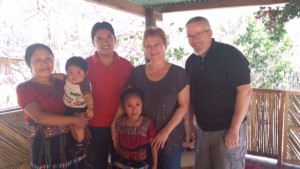 My grandson lives in San Marcos la Laguna, Guatemala and attends Escuela Caracol, an international Waldorf School. This is the only Waldorf School in Guatemala. Several months ago his mother shared a Facebook post with a link to the school’s website at https://escuelacaracol.org/. After perusing the website we learned that over 85% of the student body at Escuela Caracol comes from indigenous Maya families who cannot afford the cost of tuition. My husband and I decided to sponsor a student. Only $30 a month covers tuition and a nutritious snack for one child. Our child is Dulce.
My grandson lives in San Marcos la Laguna, Guatemala and attends Escuela Caracol, an international Waldorf School. This is the only Waldorf School in Guatemala. Several months ago his mother shared a Facebook post with a link to the school’s website at https://escuelacaracol.org/. After perusing the website we learned that over 85% of the student body at Escuela Caracol comes from indigenous Maya families who cannot afford the cost of tuition. My husband and I decided to sponsor a student. Only $30 a month covers tuition and a nutritious snack for one child. Our child is Dulce.
In February of this year, while on our annual trek to see our grandson, we visited Escuela Caracol. We were met by Joshua Wilson, Pedagogical Director, President and Co-founder. We were given a tour of the campus and were surprised to learn that the sixth graders were studying the Norse gods as well as Roman history. The classrooms were airy, bright and inviting.
Without a doubt, the highlight of our visit was meeting Dulce and her family. She was very shy. I had brought a few little gifts and she seemed embarrassed by all the attention. As Joshua translated, the family spoke about what our sponsorship means to them, stating that they would not be able to afford to send Dulce to Caracol otherwise. Her father said she attended the public school for a short while, but did not do well. She is excelling at Caracol and is now in the first grade. Their words were heartfelt. My husband and I were humbled.
To express their gratitude the family gave us a satchel made from the fiber of a certain plant that grows at the lake and was handmade by Dulce’s grandfather who had recently passed away. This satchel was a family heirloom, and they gave it to us! Then, so my husband and I would each have a bag, we were also given a newly made satchel. Amazing is a word that is often overused, but these gifts of gratitude were truly amazing.
I assured the family that we would see Dulce through to sixth grade graduation. We posed for a few pictures and I held the baby for a bit. As the meeting came to an end, Dulce indicated she wanted to give us a hug. This most precious embrace – tender and sweet – was a gift from her own heart.
We have forged a connection that will never come apart.
Sandra Levins
Burlington, Iowa USA
By Colleen Donovan, KinderCaracol Teacher
A wise woman once told me that it is futile for early childhood educators to look for the results of their work. The care given during early childhood bears its fruit much later in life, when most likely the children have long since passed out of our own lives. Instead, we must be content in the knowledge that by planting good seeds we are helping to ensure a heathy future for the children under 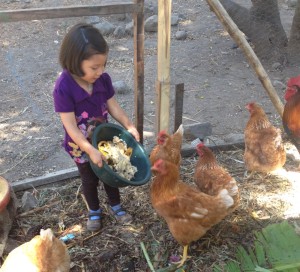 our care.
our care.
Now, of course there are triumphs to be recognized throughout the year: the boy who has trouble sharing one day freely offers his toy to a playmate, the little girl who arrived weepy for the first few weeks of class walks in one morning with a bright smile. But it is true, to a great extent, that our work is the work of gardeners who are only passing through. We try our best to select good, healthy, vital seeds and create the conditions in which they will flourish, and then we leave, never knowing for sure the outcome of our work.
Each morning, the little ones and I visit our school’s small flock of layer hens. We bring them greens, make sure they have enough grain and clean water, and spend a few minutes simply enjoying the pleasure of their company. If we are lucky there is an egg or two to collect, though usually none have been laid until we return during outdoor playtime.
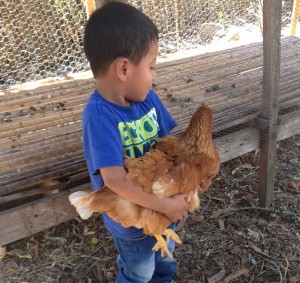 Our five minutes or so with the chickens each morning is important for many reasons. It is an act of devotion and care to tend to others who cannot provide for themselves, values which are surely needed in our world. It can be a therapeutic experience for children to hold a hen and gently stroke its soft feathers. It provides healthy, nourishing, wholesome food for snack time, when on Friday we enjoy the eggs we have been collecting and saving all week. We reconnect with the food cycle and are able to experience it as a whole, living process. And for the school, it is a help in providing some of the food for our nutrition program, in which we serve snack daily to all 80 students.
Our five minutes or so with the chickens each morning is important for many reasons. It is an act of devotion and care to tend to others who cannot provide for themselves, values which are surely needed in our world. It can be a therapeutic experience for children to hold a hen and gently stroke its soft feathers. It provides healthy, nourishing, wholesome food for snack time, when on Friday we enjoy the eggs we have been collecting and saving all week. We reconnect with the food cycle and are able to experience it as a whole, living process. And for the school, it is a help in providing some of the food for our nutrition program, in which we serve snack daily to all 80 students.
But what stands out to me the most is a deeper aspect. When we collect the eggs we are not participating in a transaction, but r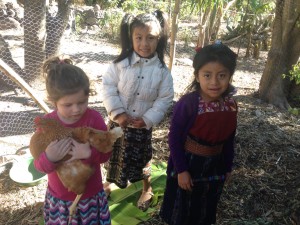 ather an exchange. In caring for our chickens, they care for us. The nature of this is so fundamentally different from that of many other activities in the modern world: providing for ourselves and providing for others becomes inseparable; it is impossible to do one without the other. These days, we have the notion of competition so constantly reenforced that it can take quite a bit of effort to see other possibilities. It is easy to forget that it does not have to be a question of providing for oneself or providing for others but that actually a third possibility exists, one in which, through care and cooperation, we all benefit.
ather an exchange. In caring for our chickens, they care for us. The nature of this is so fundamentally different from that of many other activities in the modern world: providing for ourselves and providing for others becomes inseparable; it is impossible to do one without the other. These days, we have the notion of competition so constantly reenforced that it can take quite a bit of effort to see other possibilities. It is easy to forget that it does not have to be a question of providing for oneself or providing for others but that actually a third possibility exists, one in which, through care and cooperation, we all benefit.
Of course, this is one among innumerable seeds which are planted during early childhood. It too will need care and attention if it is to flourish. But then, no fruit has ever been borne of a seed not planted.
People of Time, People of Space
Or How We Came to Study the Popol Wuj at Escuela Caracol
According to the Popol Wuj, the sacred book of the Maya, the first four humans had the vision of the gods. They could see through both space and time and understand the vast expanses of the universe. The gods soon decided, however, that this was not such a good thing, so they blurred human vision «like breath upon the face of a mirror.»
Some humans were not left totally in the dark though. They were given an ilb’al, a «seeing instrument,» namely, the Popol Wuj. With this «book of the people» and the sacred calendar it implies, they could foresee the movements of the planets, when it would rain, when there would be famine, war, death, etc. It guided their lives through time and effectively became for them a sophisticated system for the navigation of time. It was to them what GPS has become to modern people — they didn’t «go anywhere» without consulting it. It guided them in every aspect of life: when to plant, when to harvest, when to marry, when to conceive, when to build, when to travel.
Then came another people from far away who were more concerned with space and had developed extraordinarily sophisticated systems for its navigation. The space people were the people of horses, roads, boats, compasses, maps and wheels. By contrast, the only wheel used by the time people formed a part of their cyclical calendar. These space people used their advanced technology to travel a great distance and conquer the time people, and then they destroyed nearly all of the books of the time people. Only four original books (codices) survived this mammoth destruction.
Although stripped of their libraries and archives, the time people secretly retained the essence of their learning. They kept it alive through strong oral traditions, and before that first conquered generation passed, some of them even learned the alphabetic writing system of the space people. They wrote down in alphabetic script the essential content of their «seeing instrument,» the Popol Wuj, and they kept it a holy secret.
150 years later, one of the space people, a Dominican priest, became fascinated by the ideas and legacy of the time people. He learned their languages, and gained the confidence of the time people to such a degree that he was not only permitted to see this sacred text, but he also transcribed and translated it into what is now the only known surviving manuscript of the Popol Wuj.
Another 150 years passed and, upon the closing of all monasteries in Guatemala, that manuscript ended up in a university library in the capital city. There a visiting scholar of the space people (from Austria) chanced upon it, recognized its value, and decided to steal it from the library. During the years that followed, this manuscript made a variety of appearances around Europe, where many of the space people now took great interest in it. It finally ended up in a library in the «place of wild onions,» also known as Chicago, where it continues to be archived to this day.
So the space people conquered the time people and destroyed their books, but the time people learned a trick from the space people (alphabetic script) and secretly salvaged an essential component of their temporal navigational system in the text of the Popol Wuj. Then a sympathetic space man copies down and translates what has become the only surviving manuscript of the Popol Wuj. Another space man comes and steals the manuscript, trades it among the space people, who take a liking to it and start to print copies.
This rather complex story, filled with both tragedy and intrigue, depicts two different aspects of the original clairvoyance and the convoluted karmic knots between the peoples of time and space. It also explains how it came to be that we at Escuela Caracol, located in a region that is struggling to regain its literacy, came into the possession of printed copies of the Popol Wuj.
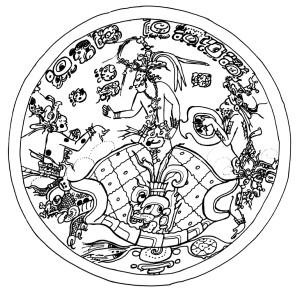 Perhaps it also hints at why Escuela Caracol, which seeks to bring the time and space people together to explore their collective destiny, has recently decided to undertake a study of the Popol Wuj together among the faculty. And perhaps it is fitting with the strange irony of this history that after 500 years this sacred text is making its way through the space people to a new generation of time people for their first reading ever.
Perhaps it also hints at why Escuela Caracol, which seeks to bring the time and space people together to explore their collective destiny, has recently decided to undertake a study of the Popol Wuj together among the faculty. And perhaps it is fitting with the strange irony of this history that after 500 years this sacred text is making its way through the space people to a new generation of time people for their first reading ever.
For me, it is a great honor and a privilege to read the Popol Wuj with the local indigenous teachers of Escuela Caracol.
– Joshua Wilson
Written in the early hours of 9 Ajmak, the day of forgiveness and redemption in the sacred Mayan calendar.